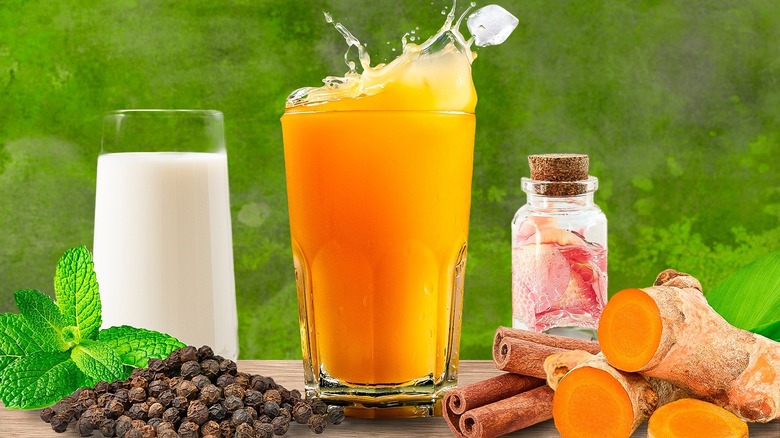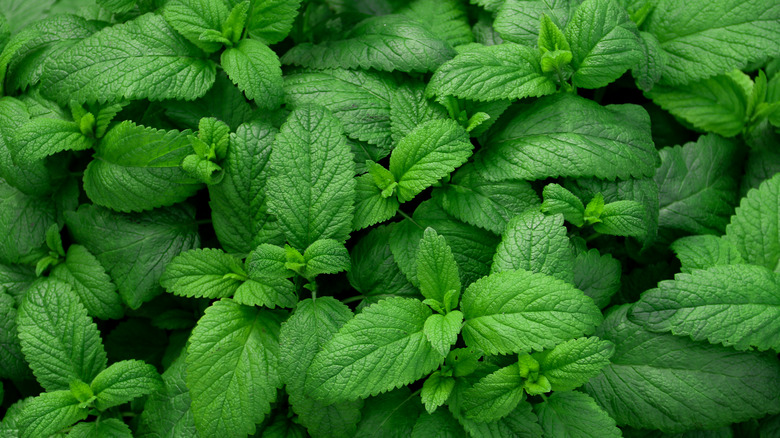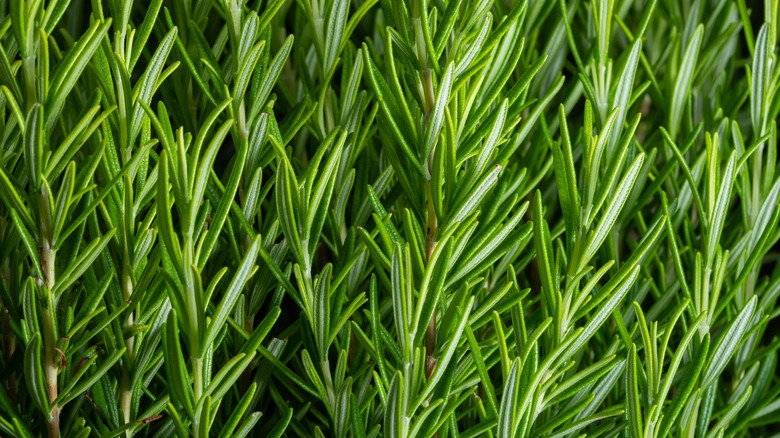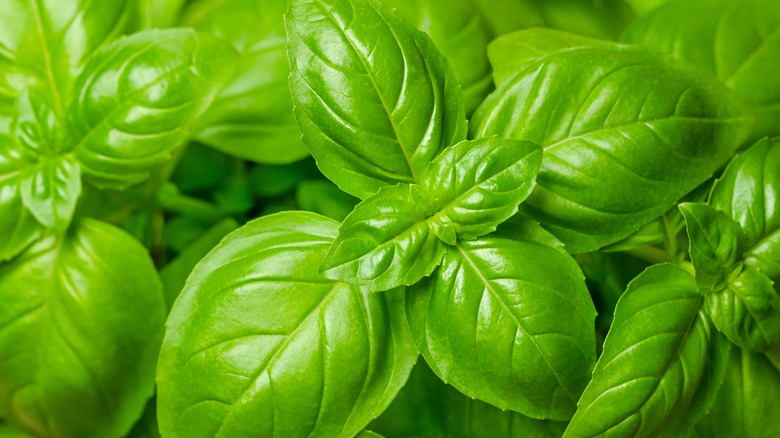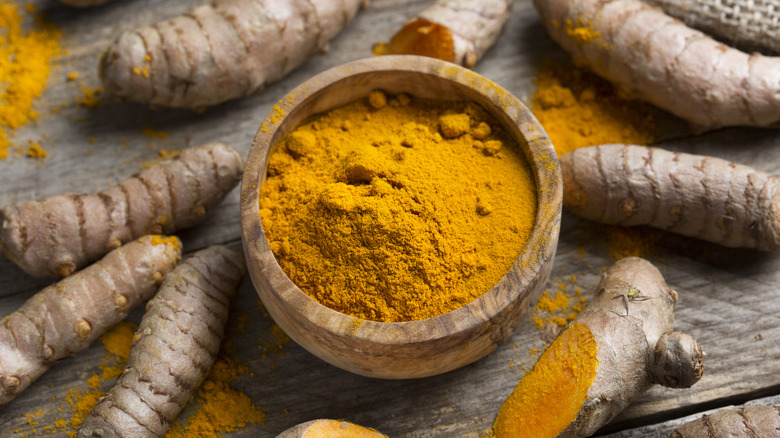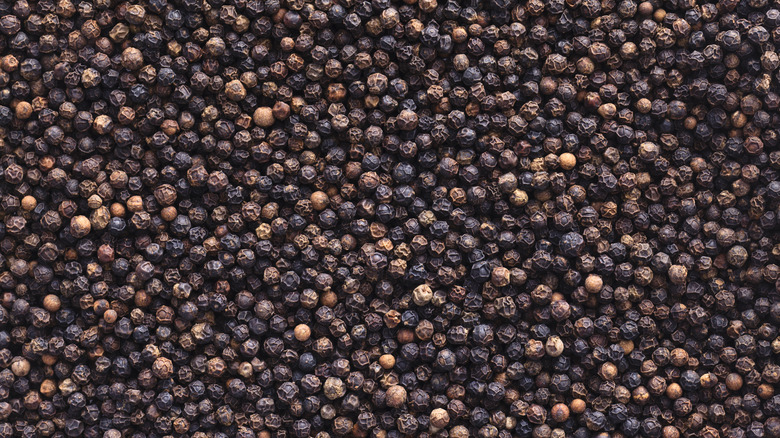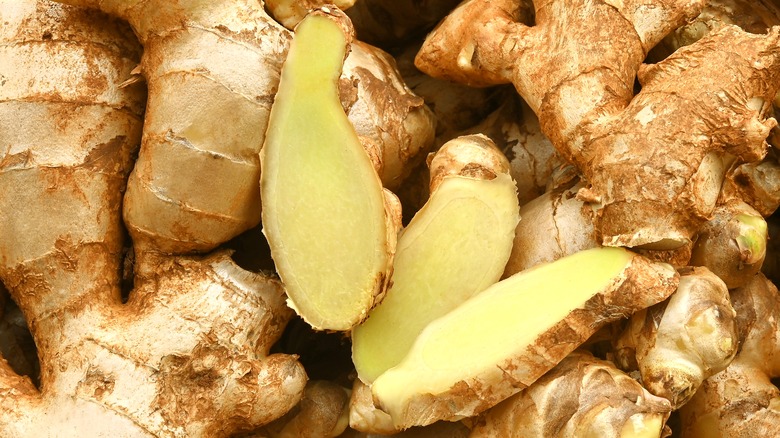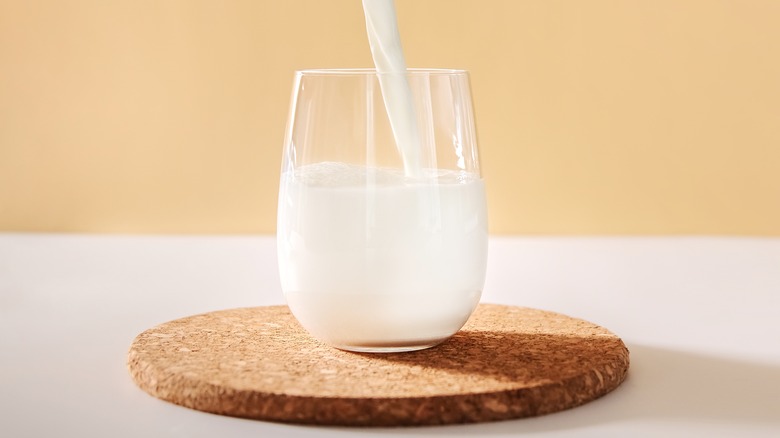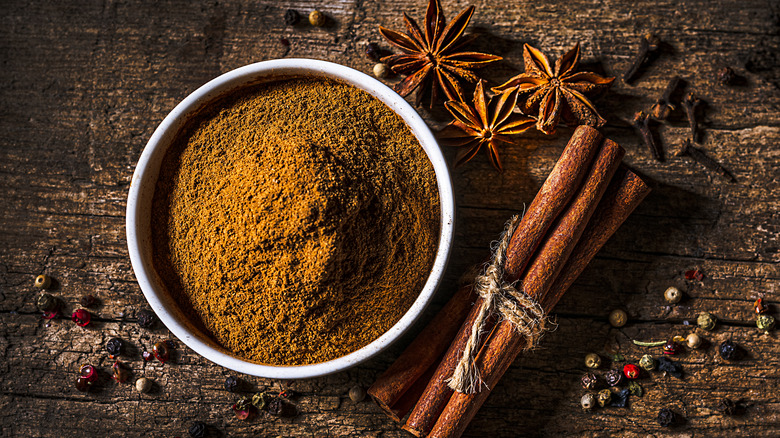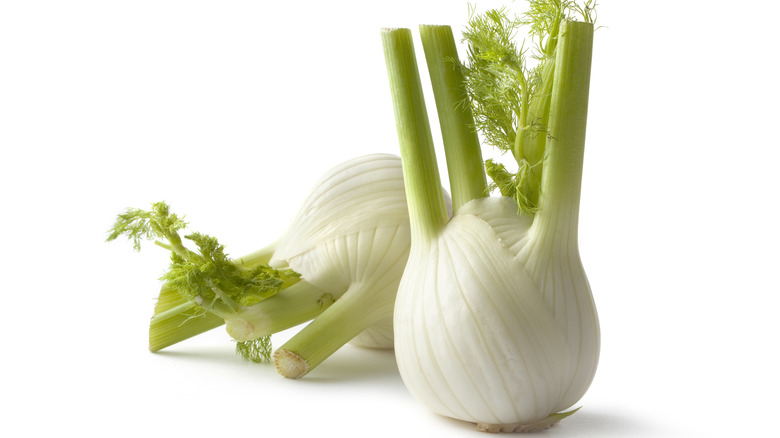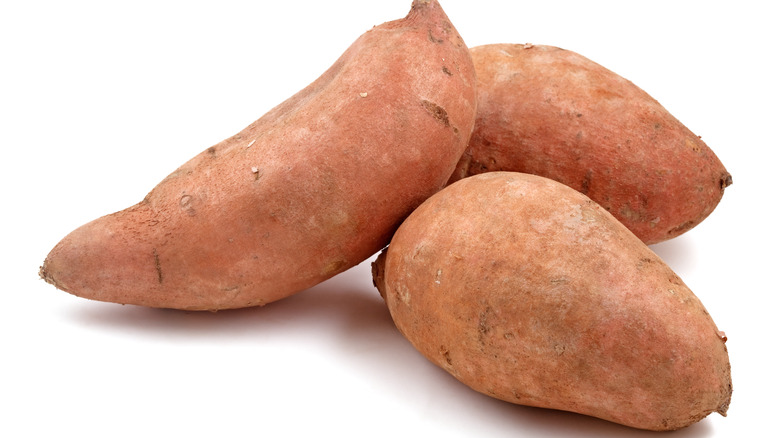13 Ways To Add Flavor To Freshly Pressed Juice
Imagine how bland life would be without beverages. Starting the day with the right one can mean the difference between a slow morning and shouting "Carpe diem!" at the breakfast table. When the heat outside is unflinching, a refreshing beverage can cool you down, and when you're having a sluggish workout, it can give you the extra push you need. In fact, there's a drink for any situation you can imagine.
While some juices are big on taste, others focus on benefits like nutrients, energy, and more. Freshly pressed juices, popularly known as cold-pressed, check the box in every category. They are one of the best and most flavorful ways to consume nutrients and, with the right equipment, are easy to play around with at home. Cold-pressed juicers extract the juice using a mechanical press. Conventional juicers, on the other hand, cut and shred fruit and veggies with a blade, and use heat to separate the pulp. While both are nutrient-dense, the former retains more healthy pulp while the latter filters it out.
If you're using either of those juicers at home ─ or even juicing by hand ─ you may be looking for ways to upgrade your flavors. Handily, there's a wide assortment of delicious and healthy combinations to try. So whether you're new to the fruit-tastic world of juicing or a seasoned juice master, here's how to add flavor to freshly pressed juice.
Mint
Like air dancing on your tongue, mint is a burst of refreshment. From beverages to savory and sweet recipes, it's easily one of the most beloved herbs around. Describing its taste is more akin to trying to illustrate an experience. It's sweet, herbaceous, healthy, and carries a calm, cooling effect that awakens the soul. There are over 600 mint varieties in the world though we only consume a few — some of which include popular mints like spearmint, peppermint, and basil mint. Although there are variances in flavor, each has an unmistakable minty feel.
Mint is one of the best herbs to use when making freshly pressed juices. Classic combinations like lemon and mint, and watermelon cucumber and mint, only scratch the surface of the flavorful possibilities. Along with a revitalizing taste that freshens your breath, mint is also nutritious. We definitely suggest adding it to your next batch of summer lemonade. A ⅓ cup (or half an ounce) of spearmint contains 12% of your recommended daily intake of Vitamin A and is also packed with antioxidants. With so much to offer, you literally have every reason to experi-mint. Oh, and make sure to be mindful of how much you use when making freshly pressed juice because the flavor can quickly overpower.
Rosemary
Rosemary is another herbaceous ingredient that you absolutely must try in your juice. Whereas mint is fresh and invigorating, rosemary is woodsy and savory, with a bitter aftertaste. It originates from the Mediterranean and is actually a member of the mint family. Although Rosemary can be used in sweets, its flavor profile is generally paired with rich and salty foods. The reason is due to its potent taste, which, unlike most herbs, can withstand hot temperatures for long periods.
Since rosemary is so potent, we suggest only using two to three sprigs per cup of juice. Its flavor profile pairs best with juices such as pear, apple, or pomegranate. Rosemary's fragrant qualities will also elevate your everyday pineapple, lemonade, and watermelon juice. Beyond providing grassy goodness, it is also loaded with nutritional health benefits. According to WebMD, using rosemary is a great way to boost your pressed juices with additional immune system-enriching, stress-reducing, and potentially cancer-fighting powers.
Basil
This next herb has many of the same qualities as mint and rosemary but is also believed to have spiritual powers. Basil is one of the most widely used herbs in cooking. It was cultivated over 5,000 years ago and is a common ingredient in cuisines from around the world. It's viewed as a religious symbol in Europe, Malaysia, and India, where it's popularly enjoyed in tea form. Although it's part of the mint family, there are only 150 known basil varieties in the world, with several types regularly used in everyday cooking.
Taste-wise, basil is both sweet and savory. The flavor profile is composed of mint, anise, pepper, and grassiness. For the maximum herby explosion, you should always use fresh basil in pressed juices. Basil is one of the best herbs to juice, its aromatic awesomeness goes great with strawberry lemonade, watermelon, and lime. For the truly health-centric people, it's also great with veggie-packed green juices.
Turmeric
While we're on the subject of healthy flavor-boosting ingredients, turmeric is hands-down one of the most flavorful roots period. It's a sibling of ginger and cardamom and originates in Southeast Asia, where it's commonly used in Ayurvedic medicine and local cuisines. Curry lovers are no doubt familiar with turmeric, as it's responsible for the sauce's vibrant yellow color. Like its siblings, turmeric is highly regarded for its medicinal properties. According to a study published in the journal Molecules, turmeric is rich in antioxidants, and can reduce inflammation, the risk of cancer, and harmful microbe build-up.
Healthy perks aside, taste is the biggest determining factor of an enjoyable freshly pressed juice, and turmeric is loaded with it. It's a colorful root that has a truly unique flavor profile. Robust is an understatement; turmeric has a strong earthy taste that's noticeably bitter and peppery. The slightest overuse will dominate the other ingredients in your juice. It's easier to measure using dried turmeric than the fresh kind — dried is also less potent. We suggest blending it with citrus fruits, pineapple, mango, and similar tropical fruits. If you want to spice things up, add some black pepper. As Healthline states, when the two are combined, turmeric's disease-preventing qualities are considerably enhanced.
Black pepper
One of the oldest spices known to humankind, black pepper was introduced to the West by Alexander the Great. Clearly, for a spice to have lasted thousands of years, it's got to be something special. Black pepper is one of the most popular spices in the world, and it's also quite nutritious. I think that can be justified by the Healthline link.. It carries a bitter, woodsy, pine-like taste, and when it comes to health benefits, you'd literally need a sheet of paper longer than a CVS receipt to list them all. While it packs some heat, unlike red peppers, it's mild and flavorful more than spicy. Use it when you want a subtle kick, but if you wanna turn up the heat, spices like cayenne and chili powder are better.
As mentioned, there are many health benefits to juicing with black pepper. For starters, according to Healthline, it may improve blood sugar levels, help brain function, and lower cholesterol, and those are only a few reasons why your pressed juices deserve a black pepper boost. A tried and true juice combo is lemon, turmeric root, ginger, and black pepper — a few sips will send a satisfying shock through your system. Citrus fruits go great with black pepper in general, along with watermelon and mango.
Ginger
The most popular member of the Zingiberaceae family, ginger has a distinct peppery yet sweet flavor that's enjoyed in food, beverages, and even desserts. Like its siblings cardamom and turmeric, it's an ancient root that was cultivated thousands of years ago. Although it's referred to as a root, the ginger found at stores is actually a root-like stem that grows underground. Nearly 1,600 species of ginger plants exist, but not all types are edible.
With its impressive list of nutrients and attention-grabbing taste, it's no surprise that ginger made its way into cuisines from around the globe. It's an extremely versatile ingredient when added to freshly pressed juice. You can use dried or fresh ginger; we recommend the latter for its robust taste. The simplest way to add fresh ginger is to peel it first, then grate it into your juicer. A vegetable peeler, knife, and even a spoon will cleanly remove the skin. Once the skin is gone, chop the roots into smaller chunks to make grating easier and safer. You'll need to experiment with different quantities to find the perfect piquant potency.
Sweetened almond milk
Among the many benefits of freshly pressed juice, the most enjoyable one is that it allows you to be creative. You can dabble with tried and true juice combinations or mix and match until you discover a new favorite. All you need is a little imagination. For example, one unlikely flavor booster for your pressed juice is sweetened almond milk. Its subtle nutty and sweet taste blends seamlessly with fruits and veggies. Not only does it add flavor, but it also provides protein and gives the juice a creamy consistency. Protein is one of the many nutritious benefits of drinking almond milk. It's also a great source of magnesium and vitamin E. You can rest comfortably knowing that with each creamy sip, you're getting a healthy upgrade.
Try recreating the iconic orange creamsicle flavor with sweetened almond milk and oranges, it's a nutritious twist on a nostalgic classic. Another surprising combo is almond milk and green juice, or simply, green milk. Unless you really enjoy vegetables, the grass-like taste of green milk is an acquired one. Almond milk adds a sweetness that balances out the bitter notes and rounds out the profile. If you're into piña coladas, try substituting almond milk with coconut milk and freshly pressed pineapple juice.
Cinnamon
Using aromatics is another way to add flavor to your freshly pressed juice. When you think of cinnamon, mixing it into juice might be the last thing that comes to mind. It is most often used in protein shakes or milk-based beverages, so although that makes sense, culinary rules are meant to be broken. Cinnamon is actually the kick your pressed juice has been missing. It provides a pleasant spice rather than a piquant one like black pepper. Closer to quiet thunder than to a lightning strike is another way to describe it. Of course, as long as you don't overuse it.
According to Healthline, cinnamon is also a powerful source of antioxidants and can even help lower blood sugar. When adding it to a juice, we recommend starting with small amounts and testing the ratio until you find a blend you like. The amount of cinnamon you use will vary with each juice recipe. Try adding some aromatic flare to citrus-based juices. Cinnamon is the perfect complement to carrot-based juices too. For those who can really take the heat, spice up an apple and ginger combo with cinnamon. Feel free to play around with different ideas.
Fennel
Licorice lovers will want to try this flavor infuser. Sweet and earthy with a subtle spiciness, fennel is a truly unique-tasting vegetable. When blended with fruit, it pops similar to cinnamon, yet is rich and woodsy. More specifically, the flavor of fennel can be described as anise-like. Despite their similarities, fennel and anise are two distinct plants. When used it can easily overpower other ingredients, so moderation is key. Fresh fennel and seeds are both widely available, but always use the actual vegetable for pressed juices. The fresh variety is more intense and is filled with natural flavor-giving juices.
When juicing fennel, all you need is one bulb. Fennel pairs well with sweet fruits like apples, pineapples, and bananas. A saccharine blend helps balance the birch-like taste. It makes sense when you think about it because licorice is most often used in baking. That said, light and subtle fruits like cucumbers also go great with fennel. If you're looking for a refreshing summer heat remedy, pineapple, fennel, and cucumber juice will definitely cool you down.
Sweet potatoes
For a dose of creamy, carb-filled goodness, flavor your pressed juices with sweet potatoes. While those tasty tubers might be unlikely ingredients, using them might convince you to ditch your go-to. They're sugary and slightly nutty, with potato-y earthiness that can be used to complement or intensify blends. When juicing with sweet potatoes, fruits like pineapple, apples, pears, berries, and well, most popular fruits, are all fair game. You'll have to experiment with various combinations and ratios to find the ideal blend, but to start, we recommend adding sweet potato to classic combos like pineapple and coconut, apple and ginger, or orange and carrot.
Before adding sweet potatoes, you should juice them first. Start by washing them thoroughly, then remove the skin with a peeler. Cut the potato down into smaller chunks so that it will be easier to juice. It only takes a few blinks of an eye to turn those starchy pieces into liquid. Now you have more control over how much you add to your juice and can experiment until you find the perfect balance.
Corn
Easily one of the last ingredients you'd think to toss into your juicer, corn is the flavor enhancer that you've been overlooking. From food to desserts, it can be used to spruce up lots of things, even freshly pressed juice. Juicing corn is as easy as any other veggie, and is sweet-tasting, creamy, and super nutritious. Corn is a healthy carb and protein-rich grain that's loaded with fiber. When juicing corn, it's claimed that fiber content is mostly lost ─ but the other nutrients and the delicious taste remain.
Similar to sweet potato, corn's flavor profile pairs nicely with sweet fruits. For example, you may find the idea of combining banana and corn strange, but if you think about it, both actually have complementary attributes. They're each used in baking and are creamy, and corn has an earthy undertone that calms the sweeter accents in bananas. Surprisingly, beet-based juices also taste amazing with a flavorful infusion of corn. Whereas corn balances the sugariness in bananas, it enhances it in beets and tempers the strong root taste. We also suggest trying it with carrot-based juices.
Essential oils
Food, roots, and spices aren't the only ingredients that you can use to add flavor; essential oils offer a whole new world of possibilities. Using essential oils in cooking is a growing trend that has lots of potential for reshaping how we cook at home. They're a concentrated plant burst that can be substituted for fresh ingredients. Before ingesting them, it's important to make sure that they are safe to consume. Most brands on the market aren't food-grade safe and are strictly for aromatherapy. In fact, the FDA keeps a complete list of essential oils that are considered safe for consumption.
With essential oils, pressed juices are your culinary oyster. Pretty much any flavor you can imagine, there's an oil for it. For some floral flair, you can add a few drops of lavender to citrusy juices. Spike your orange and carrot juice with concentrated ginger oil. You can even herbify pressed pineapple juice with aromatic sage oil. Try a health-boosting green juice with refreshing cilantro oil. There are literally endless combinations to explore.
Rose water
One flavor that's often underused in cooking is floral. It's slightly earthy, with an outdoorsy sweetness that's hard to describe without using the word flowery. From lavender to hibiscus, the floral profile can vary in taste. When it comes to freshly pressed juices, there's a whole floral frontier that awaits discovery. Rose water is a great way to introduce floral flavors to your juices. It's easy to find at local grocery stores, and although it can sometimes be pricey, you only need a few drops at a time because it's super potent. Also, rose water's distinct taste doesn't go with everything, which means that you won't use it as much. That said, when used right, it's a certified game-changer.
Rose water pairs well with sweet melon fruits, zesty citrus fruits, tart berries, and more. Blend it into freshly pressed watermelon juice for a revitalizing beverage. We suggest trying out different amounts until you find the balance you like — a couple of teaspoons is good to start off with. If you prefer berries to melons, you'll fall head over heels for pressed strawberry juice infused with rose water. The best part is that those are only two ways to add floral flavor to your pressed juice. With a little care and attention, you never know what interesting combos will bloom.
